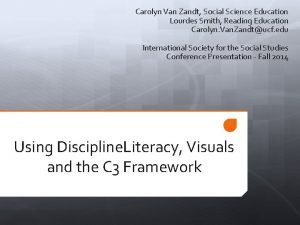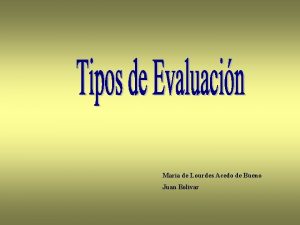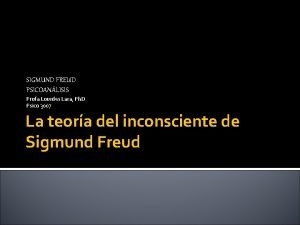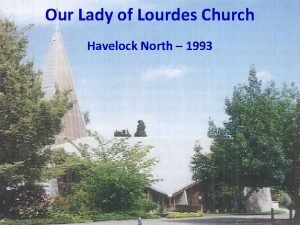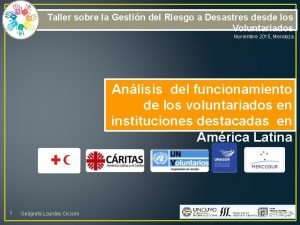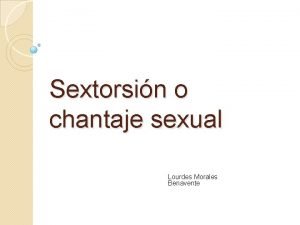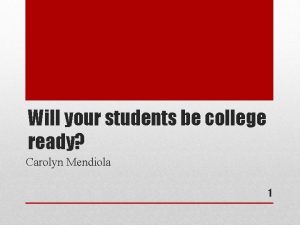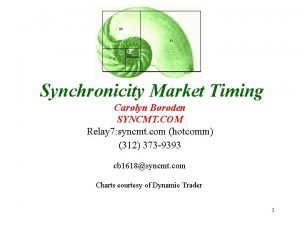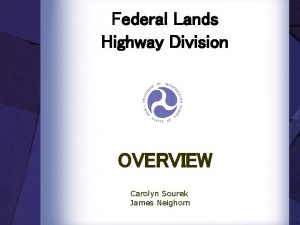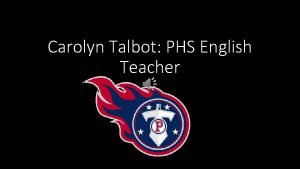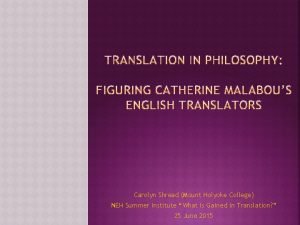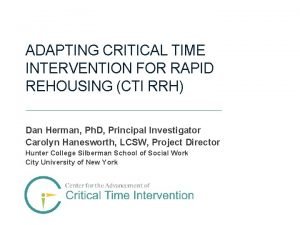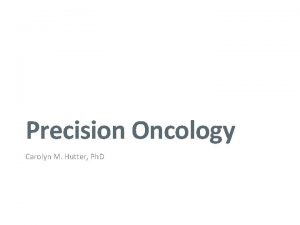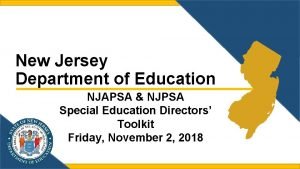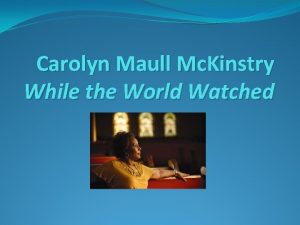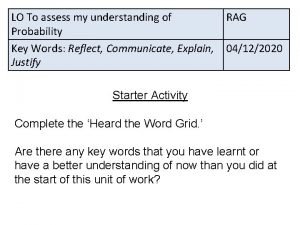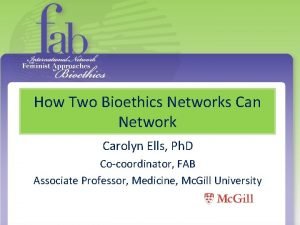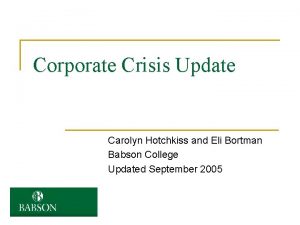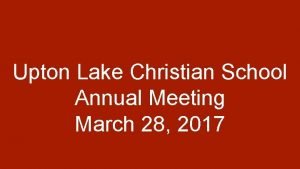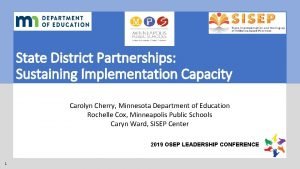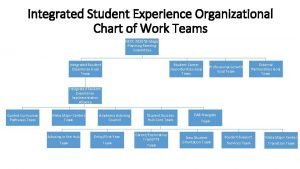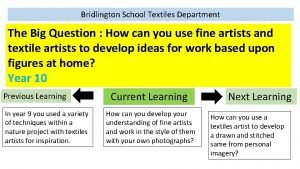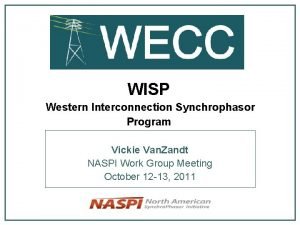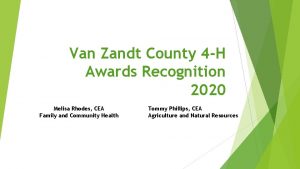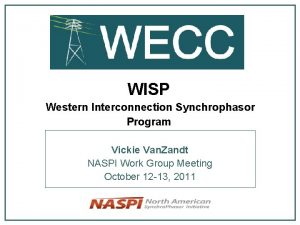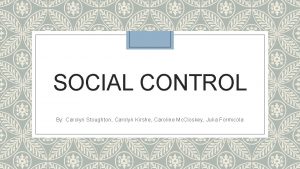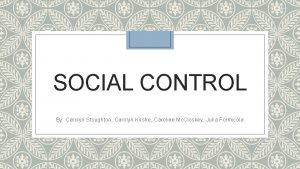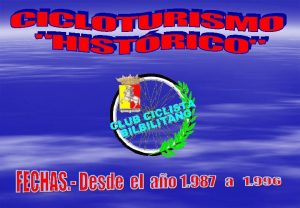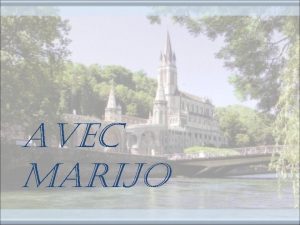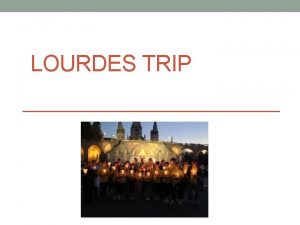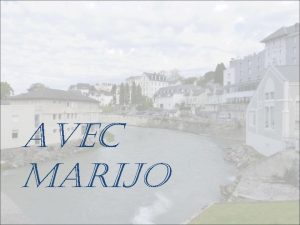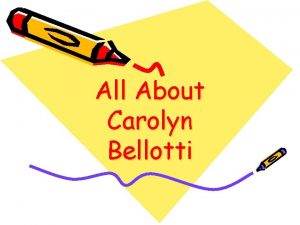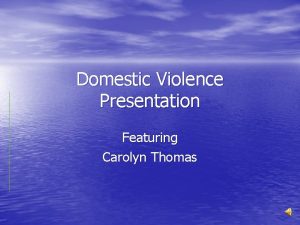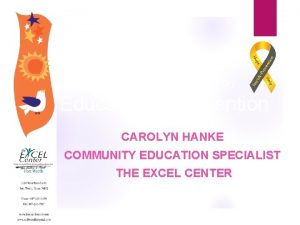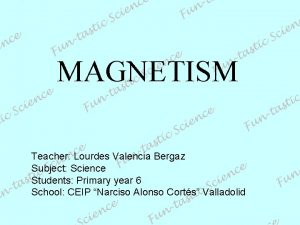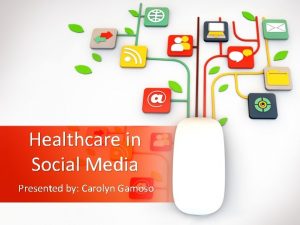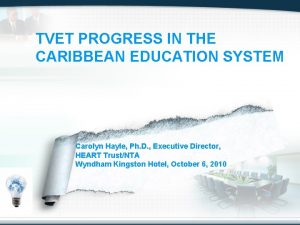Carolyn Van Zandt Social Science Education Lourdes Smith


































- Slides: 34

Carolyn Van Zandt, Social Science Education Lourdes Smith, Reading Education Carolyn. Van. Zandt@ucf. edu International Society for the Social Studies Conference Presentation - Fall 2014 Using Discipline. Literacy, Visuals and the C 3 Framework

Agenda What is the C 3 Framework What are the Literacy Domains Examples of Discipline Literacy What is Digital Literacy Discipline Literacy How to Create your Lesson Plans Resources References

What is the C 3 Framework: C 3 Foundations of the Design INQUIRY ARC DISCIPLINARY LITERACY CIVIC LIFE • The one of the big ideas in social studies education is to teach students to be active citizens (NCSS, 2010 & 2014). The new C 3 Framework is focused on helping students become critical thinking, active and engaged citizens and future voters. (Kathy Swan, 2013)

What is the C 3 Framework: The 4 Dimensions Dimension 1: Developing Questions and Planning Inquiries Dimension 2: Applying Disciplinary Tools and Concepts (Civics, Economics, Geography, and History) Dimension 3: Evaluating Sources and Using Evidence Dimension 4: Communicating Conclusions and Taking Informed Action (NCSS, 2014, p. 12) Download

What is the C 3 Framework: C 3 Framework Organization (NCSS, 2014, p. 12)

What is the C 3 Framework: Applying Disciplinary Tools and Concepts (NCSS, 2014, p. 13)

What are the Literacy Domains: Disciplinary Literacy (C 3) Civics • Using deliberative processes • Participating in school settings • Following rules Economics • Making economic decisions • Using economic data • Identifying prices in a market Geography • Reasoning spatially • Constructing maps • Using geographic data History • Classifying historical sources • Determining the purpose of an historical source • Analyzing cause and effect in history

What are the Literacy Domains: Inquiry Literacy (C 3) explanations • Questioning • Selecting sources • Gathering information from sources • • • Evaluating sources Making claims Using evidence Presenting arguments and explanations Critiquing arguments and explanations • Analyzing social problems • Assessing options for action • Taking informed action • Constructing arguments and explanations • Adapting arguments and

What are the Literacy Domains: 21 st Century Media Litercy

What are the Literacy Domains: Discipline Specific Literacy

What are the Literacy Domains: New Literacies The New Literacies include the skills, strategies, and insights necessary to successfully exploit the rapidly changing information and communication technologies (ICTs) that seem to be continuously emerging in our world. (Leu, 2002) What does this mean for educators? The nature of literacy has become deictic. We need to support teachers and students with types of new literacies.

What are the Literacy Domains: Types of New Literacies Cultural Literacy Digital/Information/Media Literacy Emotional Literacy Environmental Literacy Numeracy Print Literacy Social Literacy Visual Literacy

What are the Literacy Domains: A digitally literate person Possesses the variety of skills—cognitive and technical—required to find, understand, evaluate, create, and communicate digital information in a wide variety of formats; Is able to use diverse technologies appropriately and effectively to search for and retrieve information, interpret search results, and judge the quality of the information retrieved; Understands the relationships among technology, lifelong learning, personal privacy, and appropriate stewardship of information; Uses these skills and the appropriate technologies to communicate and collaborate with peers, colleagues, family, and on occasion, the general public; Uses these skills to participate actively in civic society and contribute to a vibrant, informed, and engaged community.

What are the Literacy Domains: What is Digital Literacy A new literacies framework suggests that teachers will become more important in 21 st century classrooms—they will function more as facilitators of student learning (Leu et al. , 2004). Digital literacy is viewed as a set of needed skills that students must develop in order be successful in current and future classrooms and careers. Digital Literacy is the ability to use information and communication technologies to find, evaluate, create, and communicate information, requiring both cognitive and technical skills. (American Library Association Taskforce, 2012)

What does Inquiry look like? In studying the Cold War students can read the Truman Doctrine, view images of the Berlin Wall, and learn about other perspectives.

Library of Congress (Resource) The Library of Congress is a virtual treasure trove where teachers can find first hand accounts, photographs, manuscripts, documents, videos, and more, to use directly in the classroom. Students can have a more authentic experience with the primary sources. An actual document can be in only one location, but digitizing it allows for greater access to students and teachers than ever before. For example, the Truman Doctrin is located in the Truman presidential library (linked to the Library of Congress) and now any student can read the actual words of this cold war policy on the digitized image of the document. This is what inquiry is about, generating interest, questioning the purpose of the primary source, and motivating the learner to extend learning. With digital inquiry more teachers are able to engage in the constructivist pedagogies of building meaning with inquiry and project-based learning. The student can gain a clearer understanding of the content and develop higher order thinking skills, in the social sciences called Historical thinking skills. Inquiry also addresses new state standards that target critical thinking literacy skills. Link Go to the Library of Congress Teachers’ Page

Library of Congress (Resource)

Reading Like a Historian

Specific Historical Thinking Skills Experts like Sam Wineburg have studied how historians analyse historical documents. By teaching Students to “Read Like a Historian, ” using these skills Teachers are engaging students in authentic learning activities. (Wineburg, 1991 & 1998)

Reading Like a Historian (Resource) Available with both online and with printed support materials Links to the Library of Congress American Memory, Digital Documents and Prints for historical analysis. RLH Link

Why Use the C 3 Framework Inquiry is a constructivist method that employs literacy skills in investigations, seeking to engage the student in the activities, helping to construct meaning by asking questions, and analyzing as the process unfolds through experiences (Stripling, 2008). The new College, Career, and Civic Life (C 3) Framework, a social studies initiative, uses Inquiry to scaffold new standards for discipline literacy with engaging community activities for students (National Council for the Social Studies, 2014).

Why Use the C 3 Framework Many new state standards are based on literacy skills that now measure student performance using critical analysis and higher order thinking skills (National Governors Association Center for Best Practices & Council of Chief State School Officers. (2010). Literacy experts identify the skills needed for reading, writing, and thinking within a specific discipline as discipline literacy (Shanahan & Shanahan 2008). Teachers use these discipline literacy skills to meet content standards (Moje, 2008; Shanahan & Shanahan 2008)

Why Use the C 3 Framework: Summation Foundation for new standards Companion to existing state standards Can align the curriculum Relationship with Literacy Professional Learning (In-service and pre-service) Curriculum and Instruction Meets new Assessment reform criteria

NCSS and Other Resources A Guide to Inquiry-based Instruction: Smithsonian, Newseum, Smithsonian American History Museum, Library of Congress, Center for Action Civics, National Constitution Center, Bill of Rights Institute, Federal Reserve, and more. C 3 Resources

Interactive Visualizations “Interactive visualization is the process of letting primary sources of information communicate directly with a viewer to support inquiry in a visual, compelling and interactive manner. ”- Bill Ferster http: //www. aag. org/cs/projects_and_programs/historical_gis_cleari nghouse/hgis_projects

Interactive Visualizations (Resources) General Lee's View of Gettysburg http: //www. nytimes. com/interactive/2011/07/27/arts/spatialmaps. html? _r=0 National Parks Service: Gettysburg http: //www. nps. gov/gett/photosmultimedia/index. htm

Interactive Visualizations (Resources) Stanford Spatial History Project http: //web. stanford. edu/group/spatialhistory/cgibin/site/gallery. php Population Density in the United States from 1790 to 2000 http: //web. stanford. edu/group/spatialhistory/cgibin/site/viz. php? id=265&project_id=

Interactive Visualizations (Resources) The Racial Dot Map One Dot Person for the Entire United States

Interactive Visualizations (Resources) University of Virginia: http: //salem. lib. virginia. edu/maps/accusation. Maps/ regionmap/regionmap. swf

How to Create your Lesson Plans

More Examples (Resources) Add C 3 to your Lesson Planning Digital DBQs Student made Videos using Primary Sources Student Presentations/Debates Research Projects

Other Resources Teachers Curriculum Institute – TCI (Social Studies Alive) http: //www. teachtci. com/programs/high-school-social- studies-textbooks-and-curriculum. html The Federal Reserve https: //www. federalreserveeducation. org/resources/classroo m/lesson-plans

References The American Library Association Office for Information Technology Policy Digital Literacy Task Force. (2013). Digital literacy, libraries, and public policy. Retrieved from: http: //www. districtdispatch. org/wpcontent/uploads/2013/01/2012_OITP_digilitreport_1_22_13. pdf Berson, M. J. (2004). Digital images: Capturing america's past with the technology of today. Social Education, 68(3), 214. Retrieved from http: //ezproxy. net. ucf. edu/login? url=http: //search. ebscohost. com/login. aspx? direct=true&db=eric&AN=EJ 703243&sit e=eds-live&scope=site Ferster, B. (2013). Interactive visualization: insight through inquiry. MIT Press. Leu, D. J. , Jr. (2002). The new literacies: Research on reading instruction with the Internet and other digital technologies. In A. E. Farstrup & S. J. Samuels (Eds. ), What Research Has To Say About Reading Instruction (3 rd ed. , pp. 310 -337). Newark, DE: International Reading Association. Leu, Jr. , D. J. , Kinzer, C. K. , Coiro, J. L. , & Cammack, D. W. (2004). Toward a theory of new literacies emerging from the Internet and other information and communication technologies. Retrieved from: http: //www. readingonline. org/newliteracies/lit_index. asp? HREF=/newliteracies/leu Moje, E. B. (2008). Foregrounding the disciplines in secondary literacy teaching and learning: A call for change. Journal of Adolescent & Adult Literacy, (2), 96. Retrieved from https: //login. ezproxy. net. ucf. edu/login? auth=shibb&url=http: //search. ebscohost. com/login. aspx? direct=true&db=eds glr&AN=edsgcl. 188158038&site=eds-live&scope=site National Council for the Social Studies. (2010) National curriculum standards for the social studies: A framework for teaching, learning, and assessment. Silver Spring, MD: Author. Information about these standards is accessible at http: //www. socialstudies. org/standards.

References National Council for the Social Studies. (2014) Social studies for the next generation: Purposes, practices and implications of the college, career, and civic life (C 3) framework for social studies state standards. Silver Spring, MD: Author. National Governors Association Center for Best Practices and Council of Chief State School Officers. (2010). Common core state standards for English language arts and literacy in history/social studies subjects. Washington D. C. Author. Shanahan, T. , & Shanahan, C. (2008). Teaching disciplinary literacy to adolescents: Rethinking content-area literacy. Harvard Educational Review, 78(1), 40 -59. Stripling, B. (2008). Inquiry: Inquiring minds want to know. School Library Media Activities Monthly, 25(1). Swan, Kathy (2013). Achieving the C 3: An exploration into 21 st Century social studies. Pearson Virtual Conference. Wineburg, S. (1991). Historical problem solving: A study of the cognitive processes used in the evaluation of documentary and pictorial evidence. Journal of Educational Psychology, 83(1), 73 -87. doi: 10. 1037/0022 -0663. 83. 1. 73 Wineburg, S. (1998). Reading abraham lincoln: An Expert/Expert study in the interpretation of historical texts. Cognitive Science, 22(3), 319. doi: 10. 1207/s 15516709 cog 2203_3 Zygouris-Coe, V. I. (2014). Teaching discipline-specific literacies in grades 6 -12: Prepareing students for college, career, and workforce demands. New York: Rutledge.
 Mui van zandt
Mui van zandt Newseum
Newseum Lourdes zolezzi
Lourdes zolezzi Feliz dia de la virgen de lourdes
Feliz dia de la virgen de lourdes Lourdes acedo gallardo
Lourdes acedo gallardo Historia de bernardita y la virgen
Historia de bernardita y la virgen Freud lourdes
Freud lourdes Our lady of lourdes havelock north
Our lady of lourdes havelock north Lourdes palomino
Lourdes palomino Docteur baco lourdes
Docteur baco lourdes Lourdes cicconi
Lourdes cicconi Sextorsin
Sextorsin Science science science
Science science science Caroline mendiola
Caroline mendiola Carolyn boroden
Carolyn boroden Who is the poet of how to tell wild animals
Who is the poet of how to tell wild animals Carolyn sourek
Carolyn sourek Carolyn talbot
Carolyn talbot Carolyn johnston md
Carolyn johnston md Carolyn shread
Carolyn shread Carolyn graham jazz chants
Carolyn graham jazz chants Carolyn hanesworth
Carolyn hanesworth Stury
Stury Carolyn marano
Carolyn marano Carolyn brownawell
Carolyn brownawell Carolyn maull
Carolyn maull Carolyn has 20 biscuits in a tin tree diagram
Carolyn has 20 biscuits in a tin tree diagram Carolyn ells
Carolyn ells Carolyn hotchkiss
Carolyn hotchkiss Upton lake christian school
Upton lake christian school Carolyn washburn
Carolyn washburn Carolyn cherry
Carolyn cherry Carolyn knoepfler
Carolyn knoepfler Carolyn saxby facts
Carolyn saxby facts Natural vs social science
Natural vs social science

